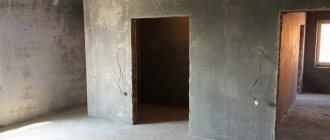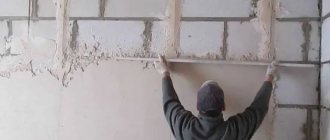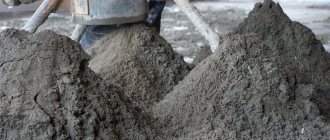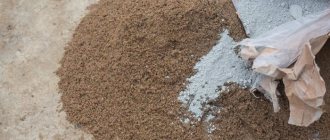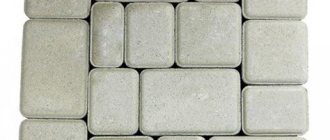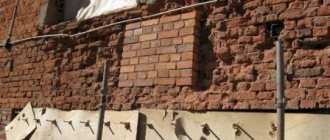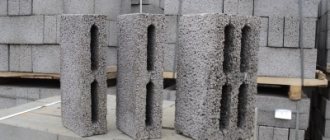The topic of this article is mortar for plaster, but not a general description and tips for use, but specific information about the composition and proportions. This information will help you achieve the desired result of the repair: excellent appearance, strength and durability of the coating.
Plaster solutions are used for various purposes, for example, for leveling or decorating facades or interiors. But an important function of the plaster composition remains the protection of external and internal structures of buildings from various influences.
In order to prepare the required composition for plaster with your own hands, you need to have an idea of the correct proportions of the components (volume or weight). You also need to know in what form and in what order the components are mixed.
Why does one solution have different proportions?
Leveling plasters consist of several layers that have different functions:
- the spray is intended to create a strong connection between the base material and the overlying, main leveling layer;
- the covering is designed to give the main leveling coating the required evenness, and sometimes smoothness (the required surface quality for gluing wallpaper, applying paint);
- primer – the main leveling material, applied in one or more layers.
Since the functions are different, the solutions differ in their proportions and components. For example, for covering you need a finer filler, since the degree of roughness of the finish depends on the size of the grains. For spraying, the mixture is made thinner than for soil. Confusing the compositions for different layers is a violation of the finishing manufacturing technology.
applying a layer of spray
base layer
cover
The period from the moment of mixing the plaster mass to the beginning of its setting is called the life span. At this time, the plaster solution is mobile and can be applied, giving the mixture the desired shape. The lifespan depends on the types of components and composition. For example, gypsum has a short lifespan. To increase or shorten this period, additives are added to the mixture - hardening accelerators or retarders.
In addition to these additives, to give the plaster mixture the necessary qualities, antifreeze (for plastering walls in winter), antifungal and other additives are introduced. Any additives require a fairly precise dosage, since they have their own chemical formula. Their excess can significantly deteriorate the properties of the finished coating.
Compliance with the ratio of plaster components is important. Therefore, when mixing a mixture of individual components or diluting ready-made dry formulations, follow the recommended proportions. This is the only way you will create a plaster stone with the desired qualities.
Plastering walls
The finished finishing solution is applied to the surface. During hardening, the layer contracts (shrinkage). As a result, cracks appear and the plaster layer lags behind the base. To avoid this situation, metal reinforcing mesh is traditionally used. This technology is proven and reliable. At the same time, it has a number of disadvantages, including the labor intensity and complexity of the production process.
Modern methods include preliminary priming with an adhesive composition to ensure high-quality fixation of the mass on a vertical plane. With this technique, reinforcing mesh is not required. The plaster mixture is applied immediately, preventing the primer from drying out.
Automatic wall plastering Source static.ex-in.online
Types of plaster mortars, their composition and proportions
In fact, plaster coatings are artificially produced stone. We can influence the characteristics of this stone already at the stage of preparing the relevant components, dosing, mixing, applying to the wall and creating appropriate conditions for hardening of the composition.
In the mixed composition, each of the components does its job:
- binds other components (astringents that react chemically with water, forming crystalline bonds);
- serves as a frame that already has strength, creates a structure (fillers are mainly chemically inert), creates a thermal or noise barrier (for example, perlite sand);
- becomes a medium in which particles of materials are placed and, at the same time, participates in the chemical transformation of the binder (water or solvents in polymer compositions);
- contribute to the quality of the solution itself and the properties of the artificial stone (various additives);
- give color to the solution and finished plaster (dyes and pigments).
All together, these components form a solution, which, when transformed, becomes an artificial stone.
The following are used as binders:
- cements (mainly Portland cement, also for plaster compositions...);
- plaster (alabaster and plaster are found on the counter);
- lime (quicklime and boiling water);
- clay;
- various polymer resins.
Application process
There are several technologies for plastering with cement-based compounds. Layers can be applied manually or by machine using injection screw pumps for cement mortars.
Preparation of the grounds
It is necessary to prepare the walls for plastering as follows:
- The old coating - paint, wallpaper, peeling plaster - is removed from the rough base and dirt is cleaned. The surface must be dust free.
- Minor defects are repaired.
- A receptive surface is then created.
- Brick, concrete or slag concrete surfaces will need to be roughened by making notches at least 10 mm deep using steel brushes or an ax.
Plastering
Working with leveling coatings on a cement binder includes three stages:
- Spraying - the mortar mixture is thrown in lumps onto the base base using a ladle. Then they take the rule and level out the spray spots.
- Soil layers (from 1 to 3). The formation of the soil is carried out using a trowel and a thick solution. The maximum layer thickness is 0.5 cm. The mixture is allowed to set for half an hour, after which, using the rule and, if necessary, adding the solution to problem areas, the surface is leveled.
- Front layer (covering) - the coating is moistened and a falcon is used to apply the mortar mixture. As soon as it begins to set, you can proceed to grouting using the same trowel or trowel.
Purpose of the components of the plaster mortar
As we already know, the plaster mixture consists of many different components. Each of which is important and performs its own functions. An excess or deficiency of one of the components of the solution will lead to a loss of quality. That is why it is important to know the purpose and functions of the components of the mixture.
Binder in plaster mortar
If the plaster solution contains only one binder, the composition is called simple. If there are two or more binders - complex. Not all binders get along with each other. For example, gypsum and cement are chemically unfriendly to each other. Therefore, they are used separately or with other binders.
cement
gypsum
clay
All binders, except polymers, are mineral substances, which is why plasters have the same name. Gypsum, cements and lime are pre-treated thermally, as a result they lose water and are able to react to its presence. When combined with water, these substances form saturated solutions and create crystals.
Liquid in plaster
The solution usually contains more water than is required for crystal formation. Liquid is also needed to give the mixture mobility (workability). In this case, excess moisture can be harmful (the strength of the solution decreases). It is for this reason that the ratio of water and other components must be observed.
Fillers
The production of binders, in addition to clay, requires a lot of costs, so they are much more expensive than fillers such as sand or sawdust. In addition, a solution containing only binders cracks when hardening. Therefore, to reduce the amount of binders (the cost of the solution), as well as to reduce cracking, fillers are introduced into the composition.
Fillers also give solutions a certain structure, for example, coarse sand is used for “bark beetle”; for other decorative mixtures, artificial or natural fibers and shell fragments are used as fillers.
It is better to purchase decorative mixtures ready-made. Their composition was developed and tested in practice by specialists.
Rough (leveling) plaster more often than other components has to be prepared on site. The consumption of leveling plaster mixture is higher, and the cost of a mixture prepared by yourself is lower.
Special additives for plaster mortars
To provide the plaster solution with the desired properties, modifying additives (universal and narrowly targeted) are used. Additives affect the binder (cement), enhancing or neutralizing its individual properties.
In solutions, additives perform the following functions:
- accelerate/slow down the process of crystal formation (setting), for example, for gypsum, the retarder is bone glue, milk, PVA;
- increase frost resistance (ferric chloride and other salts);
- improve plasticity (serve for some retention of water in the solution, prevent the process of delamination of the mixture), for example, liquid glass;
- increase the strength of the mixture (for example, reinforcing fibers (fiber) or additional binders).
Video description
Watch in the video how mechanized plastering of walls occurs:
Before throwing the material onto the plane, beacons are placed so that after drying you can see how much shrinkage has occurred. Mixture consumption per 1 square meter with a layer thickness of 5 mm is 5-6 kg. If the thickness is 10 mm, the consumption will accordingly be 10-12 kg per square meter.
Using a spatula or trowel, apply the finished emulsion onto a grater or rule, moving it from the bottom to the top for uniform distribution over the plane.
Apply onto small areas with a spatula or trowel. After spreading over the entire area, the plaster is finally leveled with a trowel. Large volumes of work are divided into separate sections so that the mixture does not fall off and you do not have to do everything again.
The finished plaster lays down beautifully and evenly Source tekato.ru
Drying of the finished layer takes several days, sometimes it takes two weeks for the cement-lime mortar to completely dry and shrink. It is advisable that during this period the air temperature does not exceed 10-20 degrees. At a comfortable temperature, moisture evaporates gradually, which prevents cracking and peeling.
In hot weather, it dries quickly, first microcracks appear, then large ragged cracks. At elevated temperatures, it is advisable to shade the wall or cover it with polyethylene. Needless to say, sub-zero temperatures are unacceptable for the drying process.
After drying, apply a thin finishing layer and dry again. The wall is ready for painting or other decorative finishing.
Wall alignment Source diy.obi.ru
Specifics of plaster compositions
Since buildings need to be plastered outside and inside, where the finishing is exposed to different conditions for a long time, the compositions of plastering solutions are also specific. Facade surfaces are subjected to more severe mechanical stress, are watered by rain, hit by hail, endure frost and heat, and are scorched by direct sunlight. Therefore, solutions for external conditions should be more resistant to all these “troubles”.
There are mixtures for facades, interior work and universal ones. The latter can be equally used for outdoor and indoor decoration.
All basic data on the proportions of plaster solutions for exterior and interior decoration are contained in the table from the standard.
spray and soil during external and internal plastering
The following figure shows the proportions of the covering.
cover - proportions
Composition of mortar for plastering external walls
Mortars for external walls differ in their base. Gypsum and lime compounds are not used for exterior finishing. An exception is plastering of closed loggias and balconies, where there is protection from water ingress. Therefore, the main binder for facade compositions is cement. Cement-lime (popular) and cement-polymer (more expensive) compositions are also used.
Clay is not afraid of frost and sunlight. But clay plaster must be protected from erosion. For facades in regions with a dry climate, if water does not directly fall on the plaster, plastering with lime-clay and lime-gypsum mixtures is used.
Area of use
Depending on the type and composition of the lime mortar for plaster, it is used for finishing surfaces inside and outside. These are agricultural buildings, industrial buildings, residential and public premises.
However, when working with lime, you need to take into account several nuances:
- A layer of plaster will not work if you plan to fix furniture or household appliances to the wall.
- It is not recommended to use mixtures for rooms with high humidity levels: kitchen, bathroom, basement.
Necessary tools and materials for work
To prepare mortar for plaster, you need the appropriate tools and equipment. You can mix the plaster manually (with a shovel in a trough) or in a mortar mixer (mechanically). It all depends on the amount of work and capabilities. To mix a small portion, you can use a mixer.
To get started, you should purchase the appropriate materials in advance with a reserve (about 20%):
- individual components or dry mixtures ready for mixing;
- color or pigments;
- prepare clean water (tap or rain);
- additives (available in hardware stores);
- containers;
- a shovel is useful for pouring filler into the mortar mixer;
- To open the packages you will need a knife;
- trowel (and other tools for applying compounds).
Expert advice
If you want to achieve good results and get a high-quality and durable coating, you need to take certain rules into account.
Keep the following points in mind:
- All utilities should be sorted out before using dry sheet plaster. Lay them out in advance.
- In rooms where there is a high risk of fire, use fire-resistant coatings.
- Do not install dry sheet plaster in very cold temperatures or the cardboard or paper will peel off from the drywall.
- Do not use regular sheet materials in rooms where there is very high humidity. Opt for sheets that have a moisture-resistant coating.
How to mix plaster
To prepare solutions for plastering walls, follow a certain mixing sequence. If the binder and filler are free-flowing, and the composition is mixed manually, the dry components are pre-mixed.
After this, liquid components are added to the container. In this case, liquid additives (for example, milk of lime) are added to the water in advance and stirred. In this sequence, it is possible to prepare a plaster batch with an even distribution of all components in the mixture.
Perlite sand is very light and produces a lot of dust. To facilitate the kneading process, it is moistened by pouring water into the bag.
If the batch is prepared in a mortar mixer, then water is poured in first and the engine is turned on. Then other liquid components are added there. Then cement and sand are poured. It is not recommended to pour the entire volume of water into the mortar mixer at once, since the sand is usually wet. And there is no need for excess water in the solution. Do not forget also about maintaining the proportions for the plaster.
Gypsum (gypsum dry mixtures) is poured into a container with water. The container is selected taking into account the expansion of the mortar mass.
What you should pay attention to when making cement-sand mortar according to GOST
Professional builders focus on the following nuances:
- using only high-quality lime;
- the feasibility of performing a trial batch;
- portionwise addition of water when mixing;
- using proven proportions;
- compliance with safety requirements when extinguishing;
- kneading immediately before using the composition;
- mandatory sifting of dry ingredients.
By following these recommendations, you can prepare a high-quality solution on your own, saving financial resources. When preparing the lime composition, you should be guided by the requirements of the standard and use high-quality ingredients.
Ready-made plaster mixtures
It is easier for beginners to use ready-made plaster mixtures produced by various companies. The finished mixture already contains various additives, so you can’t expect “surprises” from the behavior of the solution when laying it on the wall and hardening the mass. The packaging contains information on how to properly make the batch, the specifics of the composition and its characteristics.
Dry mixtures are prepared according to the instructions that can be found on the packaging. During transportation, partial settling of heavier filler particles in the packaging is possible. Therefore, in order to avoid some deviations in the composition of different batches, it is recommended to dilute the dry mixture entirely (the entire package).
Ready-made formulations have an expiration date. It is better to purchase mixtures that are still far from expiration date. To ensure that the finish on large walls is uniform, it is better to take mixtures for preparing plaster from one batch.
Preparing a solution for plaster is a seemingly simple job. But the quality and properties of the finish depend on how well and correctly the plaster batch is prepared.
Preparing the surface for processing
Before applying plaster to the wall, you need to carefully prepare it. The process involves removing the old decorative coating. Also, be sure to tap the existing layer of rough plaster to immediately remove any falling off pieces.
If the plaster is peeling off a lot, it will have to be completely cleaned off. Afterwards, the base is cleaned of dust and contaminants and primed with a deep-penetrating compound. When it is necessary to strengthen the wall, a special metal or fiberglass mesh is applied (for example, in old houses or on load-bearing structures).
